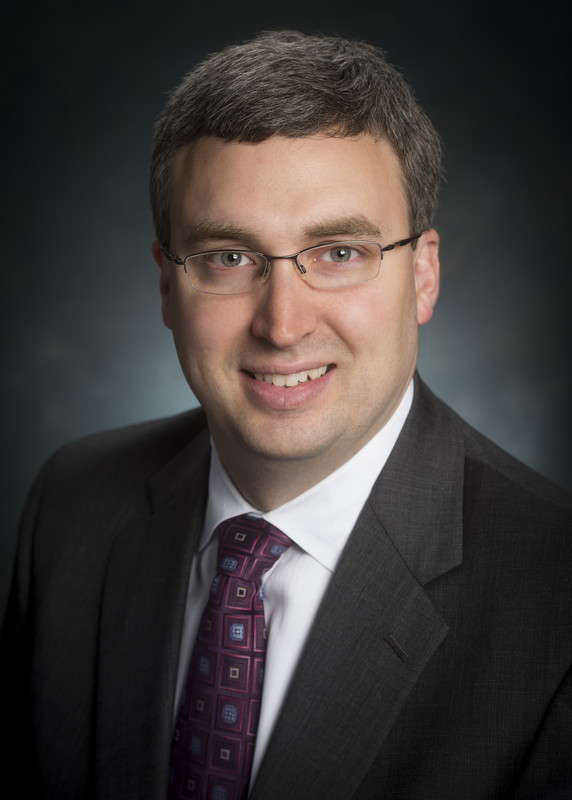 As doctors enter residency, time spent in a formal classroom is left behind for more experiential training on the job. In internal medicine, this is the realm of rotations and team-based care where teachers are attending physicians who educate as they take care of patients. This is the world where Steve Stigler, M.D., thrives.
As doctors enter residency, time spent in a formal classroom is left behind for more experiential training on the job. In internal medicine, this is the realm of rotations and team-based care where teachers are attending physicians who educate as they take care of patients. This is the world where Steve Stigler, M.D., thrives. As assistant professor in the Division of Pulmonary, Allergy, and Critical Care Medicine, Stigler rounds with trainees every day in the Medical Intensive Care Unit, or MICU, a ward where some of the sickest patients in the hospital are treated. It is a delicate balancing act to simultaneously take care of patients and explain the rationale behind the care, but Stigler sees this as a mandate for physicians in an academic medical center. “The ability to provide critical care is augmented by the need to teach residents. It makes you stay current and push yourself, so that you can provide a good educational experience for them,” he explains.
It’s this mindset, coupled with a passionate tenacity for quality improvement and patient safety, that earned him the 2015 Dean’s Excellence Award in Teaching.
In the four years since Stigler joined the faculty, he has helped lead a formalization of the MICU rotation, refining a faculty-driven “morning report” curriculum for the residents.
In the MICU, the experience involves important pulmonary and critical care topics such as mechanical ventilation, sepsis, and respiratory distress. “Surya Bhatt, M.D., and I co-manage MICU curriculum. Almost all the pulmonary faculty members contribute one morning a month to teaching the residents in 45-minute blocks; and we include teachers from other divisions, too, to create a more multi-disciplinary approach,” Stigler says.
The topic Stigler personally teaches in this format is Acute Respiratory Distress Syndrome. It’s a subject that he spent time researching as a fellow, and one that offers complex challenges to the trainees. “There’s a good evidence base for ARDS, and it’s interesting to read about. It’s also sufficiently nuanced that there are levels of differing opinions on some aspects of care,” he comments.
Aside from the morning reports, the remainder of Stigler’s teaching is much less predictable, owing to the fact that it’s ultimately patient-driven. “For a while I did PowerPoint, and then I realized no one wants to look at slides at 7:30 in the morning when you’ve got tons of other stuff to do,” Stigler laughs. Instead, he opted for case-based discussions. That way, he can find out who’s on call that day and coach the residents from actual patient files on symptoms to notice and treatment approaches to consider.
For Stigler, a good teacher’s toolbox isn’t necessarily filled with trendy gimmicks or flashy new tech. Rather, his tool of choice is the simple, intentional, and hopefully thought-provoking question. In group settings, he says, “If I ask open-ended question, I try to give them space to think about it, use the silence to my advantage. Eventually somebody will talk.”
It’s a teaching approach Stigler picked up from one of his favorite instructors, Taylor Thompson, M.D., director of Critical Care Translational Research at Massachusetts General Hospital, where Stigler completed his residency and fellowship training. As Thompson would present his own preferred treatment plan, then alternate opinions from the latest studies, it promoted lively discussion among the trainees and deepened their understanding of the topics at hand. “Taylor had the ability to pull people out, to find interesting aspects of the patient condition and speak from a great level of expertise, and to bring an incredible knowledge of the literature, applied to the specific patient. It made the people working with him want to be better doctors,” he recalls.
While Stigler primarily asks the questions in his teaching, he really prefers it when the students turn the tables and point the interrogatives at him. It demonstrates a level of engagement and understanding that lets him know they are really “getting it.” Even better, is when they keep asking questions after rounds or reports have come and gone. “I encourage residents to reference the literature whenever they can. We are in an era of life-long learning. What we think today may not be true in five years,” he states.
Stigler also makes it a point to offer opportunities to ask questions more reflectively in the MICU weekly Morbidity and Mortality Conference. “It’s an opportunity to both look at things critically from a quality standpoint, and also do a lot of education around things that happen in the MICU.” For residents who may have worked with a patient intensively, and return to the next day’s shift to learn the patient died overnight, it provides a safe place to consider whether something could have been done better. It’s an affirming atmosphere where input from their peers can bring closure—a key to their continued development as physicians.
At the end of the day, Stigler recognizes that it’s all about training the next generation of clinicians to be the very best they can be. “I hope that there are people I positively influenced in their degree of intellectual curiosity, their desire to understand the evidence for what we do, and in their clinical practice. I like to think we all better understand truth as we discuss and debate it,” Stigler said.